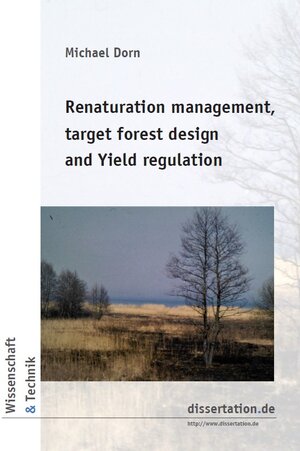Renaturation management, target forest design and Yield regulation
von Michael DornThe question posed in this article is to examine which sustainability system is to be preferred on the basis of which parameters when calamities occur. In this context, problems of comparability of the systems arise, which are mainly due to the length of the rotation cycles or rotation periods. Another difficulty is to describe evolutionary developments in forestry in a new way and to make the knowledge gained usable for the research question. Nine models are sampled with simulation technology and evaluated with different parameters; the climate protection performance of the systems is also included in the evaluation. Essential criteria of the comparison are the comparison of calamity quantity and increment, as well as the evaluation of the forest value with a combination of evolutionary and calamity-related parameters. The results of the study show that the permanent forest performs better than expected. Normal forest models are also well adapted to sustainability conditions in the case of calamity. Yield regulation under incomplete information at the onset of calamities is advantageous
with the theory of landscape equilibrium, since both the total growth rate and the level of the cutting rate can be better estimated.
A design of the natural capital definition according to Daly (1999) with evolutionary parameters allows a ranking of the study models. Management processes can thus be better evaluated. An implementation of evolutionary parameters in the systematics of renaturation becomes necessary from the results of the study.
The question of this study deals with increasing the accuracy of a target forest definition on the basis of diameter for the derivation of cutting rates. The problem arises from the fact that although data is available from the BWI 2013 for each federal state, it is based on a distribution that was determined during the federal forest inventory. Primeval forest models cannot have played a special role in this, at most permanent forest or plenter forest to generally near-natural forest forms, which in their indifferent characteristics cannot provide a data basis for the target forest design of a primeval forest model. From the simulation results for a virgin forest model described by Dorn 2021, data are calculated with the help of the individual tree values and the stand table from the BWIN-PRO programme of the Northwest German Research Institute, which are compared with those of the Federal Forest Inventory. The results show that for each of the four primeval forest model phases, deviations from the BWI data occur to a greater or lesser extent, which are so significant that it is necessary to design a separate target forest model on the basis of diameter in order to derive an accurate cutting rate.
The problem at hand for this study deals with the yield regulation of manageable, primeval forests from an evolution-based perspective. In this context, target forest parameters are determined for different management models based on typical primeval forest dynamics with the help of BWIN simulations (Nagel 2009) and cut rates are determined with classical formulae according to utilisation rate guidelines (BMF 2017) for stands that are to be converted into manageable, primeval forest-like stands. By comparing the utilisation possibilities with the silvicultural individual planning, which is interpreted as the will of the forest owner, probable calamity savings can be determined with evolution percentages. In this way, models for different calamity regimes can be selected to mimic, minimise, etc. calamities while maintaining management of potentially severely damaged stands. The advantage of an evolution-based yield regulation for CO2 sequestration is that more wood is usable without being destroyed by calamities and would only be available for energy use. Also, an evolution-based safety factor makes volume accumulation for CO2 sequestration more reliable with regard to achievable volume values, which have so far still been considered a measure of CO2 sequestration. The principle of entropy maximisation can be pursued and possibly find further application in emissions trading.
The question of this study deals with increasing the accuracy of a target forest definition on the basis of diameter for the derivation of cutting rates. The problem arises from the fact that although data is available from the BWI 2013 for each federal state, it is based on a distribution that was determined during the federal forest inventory. Primeval forest models cannot have played a special role in this, at most permanent forest or plenter forest to generally near-natural forest forms, which in their indifferent characteristics cannot provide a data basis for the target forest design of a primeval forest model. From the simulation results for a virgin forest model described by Dorn 2021, data are calculated with the help of the individual tree values and the stand table from the BWIN-PRO programme of the Northwest German Research Institute, which are compared with those of the Federal Forest Inventory. The results show that for each of the four primeval forest model phases, deviations from the BWI data occur to a greater or lesser extent, which are so significant that it is necessary to design a separate target forest model on the basis of diameter in order to derive an accurate cutting rate.
The problem at hand for this study deals with the yield regulation of manageable, primeval forests from an evolution-based perspective. In this context, target forest parameters are determined for different management models based on typical primeval forest dynamics with the help of BWIN simulations (Nagel 2009) and cut rates are determined with classical formulae according to utilisation rate guidelines (BMF 2017) for stands that are to be converted into manageable, primeval forest-like stands. By comparing the utilisation possibilities with the silvicultural individual planning, which is interpreted as the will of the forest owner, probable calamity savings can be determined with evolution percentages. In this way, models for different calamity regimes can be selected to mimic, minimise, etc. calamities while maintaining management of potentially severely damaged stands. The advantage of an evolution-based yield regulation for CO2 sequestration is that more wood is usable without being destroyed by calamities and would only be available for energy use. Also, an evolution-based safety factor makes volume accumulation for CO2 sequestration more reliable with regard to achievable volume values, which have so far still been considered a measure of CO2 sequestration. The principle of entropy maximisation can be pursued and possibly find further application in emissions trading.






